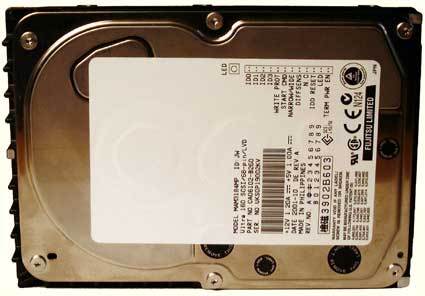Fujitsu's Silent Strike: The MAM3184MP With Ultra160 and 15,000 rpm
The Recipe: High Rotation Speed
It's no secret that the best way to speed up the access times is to increase the rotation speed, because the mechanical options for the read and write heads are pretty much exhausted by now.
There are three factors that play a role for data access: the drive logic (which determines the exact position of the desired sectors), the mechanical components (which should position the heads as quickly as possible), and the rotation speed. The higher the rotation speed, the shorter the time it takes for the desired sectors to pass the read/write heads.
Basically, an increase in data transfer performance is directly related to an increase in the rotation speed. However, this puts several aspects in the balance. Unfortunately, with an increase in rotation speed, the data density becomes a critical factor, since high speeds make high demands on the materials used - usually, it's more difficult to be exact in positioning the heads when running at high speeds of 15,000 rpm, for example. So, in order to ensure reliability, the data density is reduced.
Also, faster rotation speeds mean that further effort is needed to minimize friction and keep both noise and temperature levels within a tolerable range. High speeds result in increased friction, which leads to high temperatures. The noise level increases with the spindle motor as well. If a drive runs too hot, you will have to use an additional cooling fan, which in turn raises the noise level again.
Get Tom's Hardware's best news and in-depth reviews, straight to your inbox.
Current page: The Recipe: High Rotation Speed
Prev Page Fujitsu's Silent Strike: The MAM3184MP With Ultra160 And 15,000 Rpm Next Page Noise Level: No Louder Than 10,000 Rpm Drives
Patrick Schmid was the editor-in-chief for Tom's Hardware from 2005 to 2006. He wrote numerous articles on a wide range of hardware topics, including storage, CPUs, and system builds.
